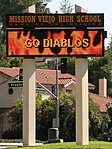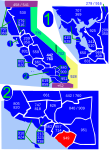Saddleback Valley

Saddleback Valley refers to the flat and foothill areas west-southwest of the Saddleback mountain peak of the Santa Ana Mountains and east-northeast of the hilly Crystal Cove State Park in South Orange County, California. The region primarily encompasses the cities of Mission Viejo, Lake Forest, and Rancho Santa Margarita, as well as the communities of Coto de Caza and Ladera Ranch. The cities of Aliso Viejo, Laguna Woods, Laguna Hills, and Laguna Niguel, as well as some of Orange County's eastern canyon communities, partially reside within the valley. The southeastern portion of Irvine also encroaches upon the area, but the two are not typically associated with each other. The cityscape within Saddleback Valley is suburban, a remote reach of the Los Angeles Metropolitan Area. The area is recently developed and on the outskirts of the Southern California megalopolis, so wildlife sightings are more common. Snakes, coyotes, and mountain lions have long inhabited the area. Mountain lion attacks on people have happened in the outlying wilderness parks of Saddleback Valley, but they are very rare.
Excerpt from the Wikipedia article Saddleback Valley (License: CC BY-SA 3.0, Authors, Images).Saddleback Valley
Madero, Mission Viejo
Geographical coordinates (GPS) Address Nearby Places Show on map
Geographical coordinates (GPS)
| Latitude | Longitude |
|---|---|
| N 33.626289 ° | E -117.681028 ° |
Address
Madero 23253
92691 Mission Viejo
California, United States
Open on Google Maps








